Odontoglossum orchid: description and care at home
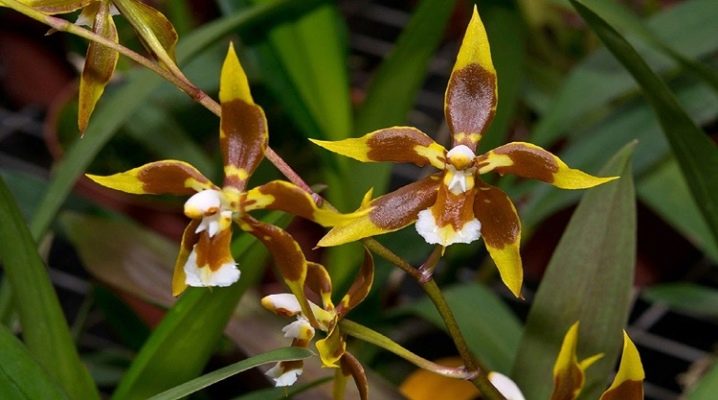
As you know, the orchid is a very thermophilic plant, so in our country you can admire it only in botanical gardens or at your window. The genus of orchids Odontoglossum migrated to the shelves of Russian stores from distant South America, Ecuador, Guatemala, Mexico and other warm countries.

Peculiarities
The Latin name for the flower is Odontoglossum. Literally translated, it can mean tooth and tongue. Indeed, at the base of the sepals, one can observe small processes that outwardly resemble a tooth. The orchid attracts with its large flowers, which are located on a branch in whole clusters. The plant usually reaches a height of about 50 cm, the root system is strong and branched.
The color of odontoglossum orchids is very diverse - from white to bright yellow and pale green. The leaves are also large, leathery, dark green in color. Over time, bulbs appear at the base of the roots - a kind of thickening in the form of small bulbs, in which the flower accumulates moisture and other resources necessary for its life. Depending on the variety of odontoglossum flowering can last up to 3 months.
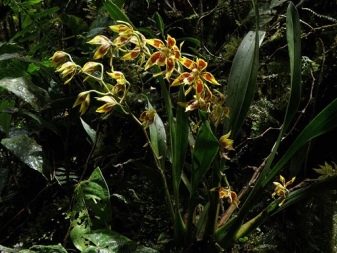
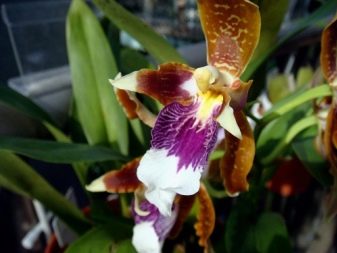
Views
The genus of orchids Odontoglossum is quite extensive. Currently, more than two hundred different species of this amazingly beautiful plant are known. This variety of varieties is due to the fact that different genera of the plant behave very well when crossed. Therefore, in a store it is often difficult to make a choice in favor of one or another instance. Let's look at some of the most common types of odontoglossum.
- Bikton. The stem has an average of 20-30 cm, shoots can grow up to 80 cm, the petals of the flower taper slightly upward, and the calyx itself is quite large - about 5 cm in diameter, resembles a star in shape. On the yellow background of the flower, large strokes are applied in a chaotic manner as if with brown paint. All this makes this type of flower very attractive.
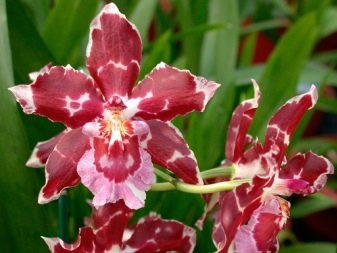

- Citric. The petals are white with a lilac or purple tint. They are not very large in size, but they surpass their counterparts in number - one plant can have up to 20 flowers during the flowering period. In the center of the flower is a bright yellow marigold.
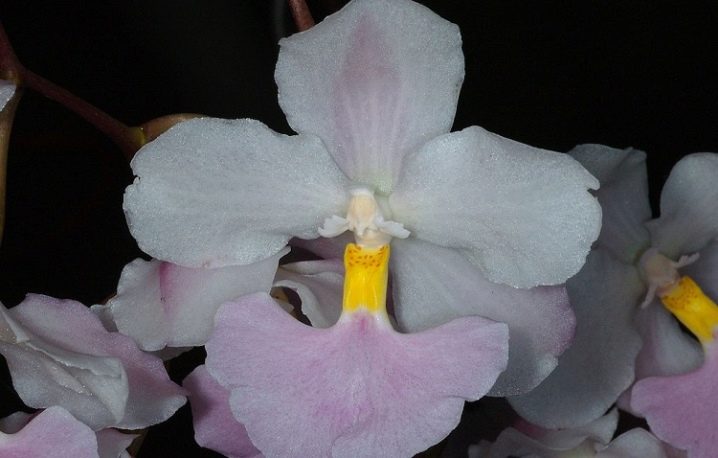
- Ross... This type of orchid odontoglossum is best suited for indoor growing. Despite the fact that its size is modest in comparison with other species of odontoglossum (stem height is about 10 cm), its bright elegant color attracts attention with its beauty. The petals are pale yellow with bold orange or brown strokes. The plant begins to bloom in the middle of spring and continues to delight with its beauty all summer, and sometimes autumn.

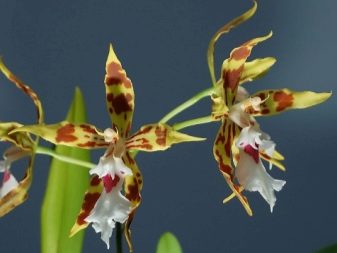
- Crispum. This is a tall species of orchid. It can reach a height of over half a meter. The leaves are elliptical. The plant pleases with abundant flowering - up to 10-15 buds can ripen on one stem at the same time. The size of the cup is 7–8 cm in diameter, the flowers resemble a bashful bride - the background is white, slightly decorated with a delicate shade of pink. The petals have a terry structure at the edges.
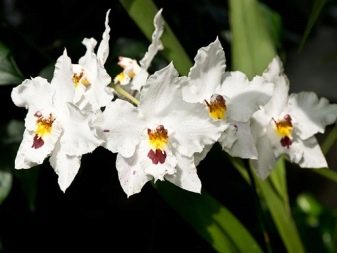
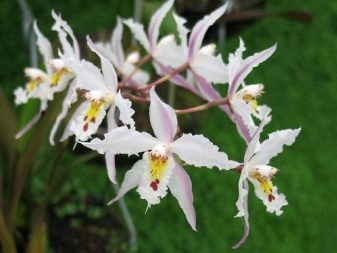
- Spotted odontoglossum resembles a variegated butterfly. The flowers are large, about 10 cm in diameter. Large purple or brown spots are presented on a yellow or white background.
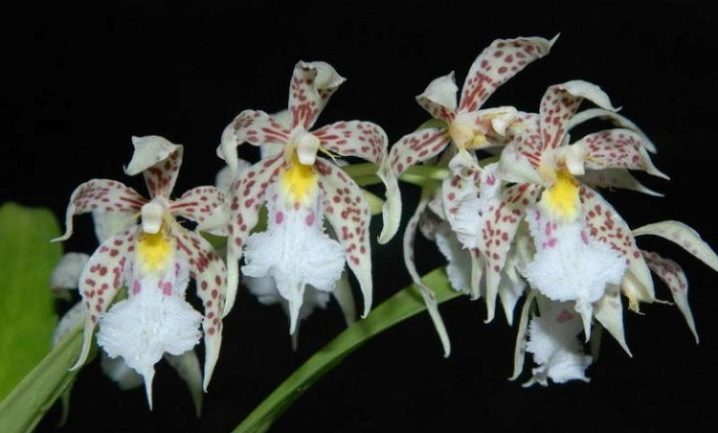
- Curly odontoglossum... The stem height is about 40 cm.The diameter of a fully opened calyx is about 7 cm. One plant can have from 8 to 20 inflorescences. The petals are boiling white, with blurred yellow or pinkish stripes and contrasting red-brown spots. At the edges, the petals are wavy, with fringed edges. Apparently, hence the name "curly".

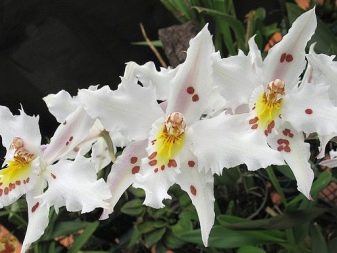
- Tiger orchid or odontoglossum large. The flowers are large, about 10 cm in diameter, dark brown at the base and bright yellow at the edges. Of all types of odontoglossum, this one is perhaps the most unpretentious. 5-6 flowers can form on one plant at the same time. They begin to appear in the autumn-winter period and delight with their appearance for about a month. Then comes a period of rest, which lasts 6-8 months.
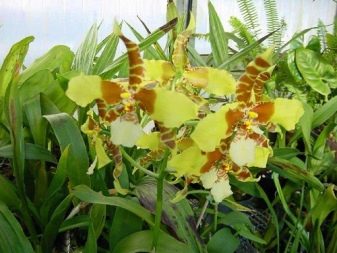
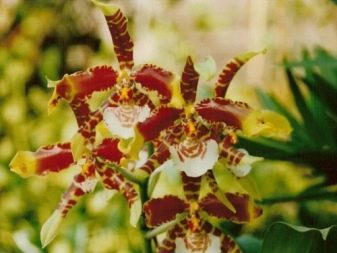
Transfer
With regards to the process of transplanting odontoglossum, it is the same as that of other varieties of orchids. It is carried out every year or twice in the fall or spring. The best time to transplant is when the plant has not yet bloomed or has already stopped blooming.
A sure sign that a plant is ready for transplant is the presence of new shoots near the base of the bulb.

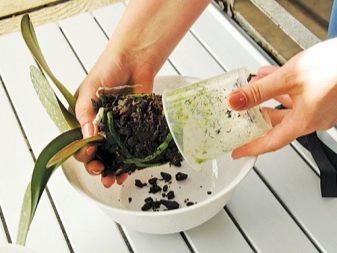
Top dressing
Fertilize orchids when they are in the active growth phase. During this period, the plant needs nitrogen fertilizers. When it begins to bloom, phosphorus trace elements are added. It is recommended to use ready mixto feed your "beauty", observing the dosage indicated on the package.
And also fertilizers for roots and flowers should be alternated.
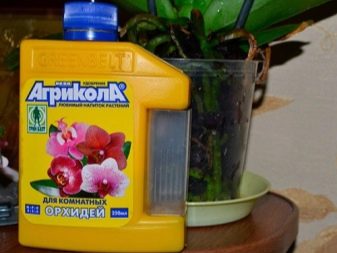

How to care?
In natural conditions, the odontoglossum orchid grows high in the mountains, where the climate is cool and the air is humid. Orchids do not take root in the soil, like ordinary plants, but on trees and even on a rocky surface. The conditions of a city apartment with central heating and often dry air are not very comfortable for an indoor flower.
When caring for a plant at home, it is necessary strictly observe the temperature regime in the daytime and at night, the level of lighting and air humidity. Therefore, most often not pure species are sold on sale, but all kinds of hybrids. Outwardly, they differ little from each other, but hybrids are considered less capricious and more unpretentious. Odontoglossum is often planted in wooden boxes, vine baskets or hanging pots with coconut bedding.
It is desirable that the room temperature in the room where the orchid is located is in the daytime it did not exceed + 20– + 22 degrees, and at night it was 5–7 degrees lower, but at the same time did not fall below the minimum threshold of +8 degrees. It is also important that the level of air humidity was at least 60%. For this, pebbles or expanded clay are placed on the bottom of the pot so that they retain moisture. It is important to regularly spray the orchid with warm (about +35 degrees) water. It is recommended to do this several times a day in warm weather and once in winter and autumn, while water should be avoided on the flower itself.
Odontoglossum loves light but direct sunlight is undesirable for the plant. It is optimal if it is partial shade. During the period of active growth, the orchid needs constant feeding.
Twice a month, the flower needs to be fertilized with vitamin B.

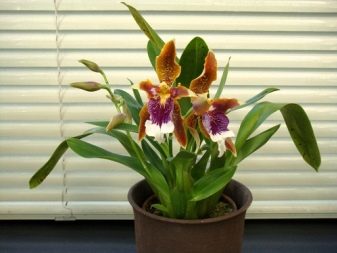
Often novice flower growers complain that the leaves of the orchid turn yellow. There may be several reasons.
- Change of habitat. Sometimes after the orchid is bought and brought into the house, its leaves turn yellow and fall off. Sometimes even all the leaves may fall off at once. In this case, there is no need to rush and panic. When a plant changes its habitat, a natural period of adaptation to new conditions occurs, which is expressed in the death of old leaves and the subsequent formation of new ones.
- Violation of the water regime. Yellowed leaves can signal an imbalance in nutrient balance. Incorrect watering regime may be the reason.The flower is sensitive to both lack and excess of moisture - both of which lead to a change in the color and structure of the foliage.
- If there is too much water, then the soil becomes compacted, presses with its mass on the roots and stops letting air to them. The result is that the leaves turn yellow, wither and fall off. In addition, bacteria often form in a stagnant environment, and the roots begin to rot. In this case, it is recommended to heal the roots - cut off the diseased, rinse and let the roots rest for several hours, and then transplant the plant into a new soil.
- Lack of moisture also leads to wilting of leaves. This may be not only an insufficient amount of water, but also too deeply located drainage, in which moisture quickly leaves and the roots of the plant simply do not have time to be saturated with it. Younger and stronger shoots begin to take away food from the earlier ones, and they quickly lose strength and wither. An overdried orchid is treated with a long (up to two weeks) immersion in water along with a pot.
- Water quality. This is another reason for the painful appearance of the leaves in orchids. The water may be too hard and contains a lot of salts. Therefore, orchids, like all plants, are recommended to be watered with sediment water. It is advisable to settle the water for at least 3 days. Melt water is very useful for flowers.
- Lack or excess of light also negatively affects the condition of the flower. In winter, the lack of light can be solved with a fluorescent lamp, and in summer it is advisable to remove the pot from the window, which is on the sunny side, and place the flower, for example, in the back of the room, but opposite the window so that the sun's rays affect the plant not directly, but tangentially. If you cannot rearrange the plant, you can simply close the window with paper, hide the flower behind other broad-leaved plants, or arrange darkening by any other available means.
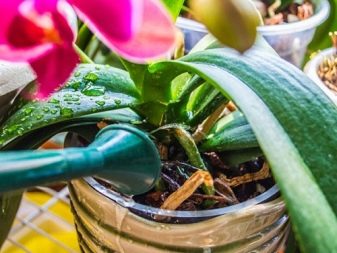
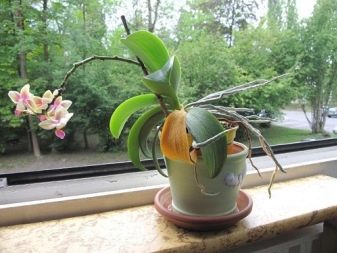
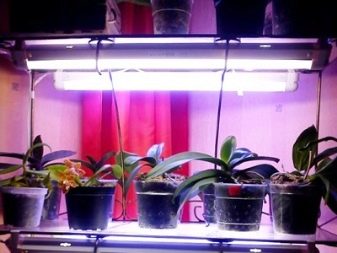
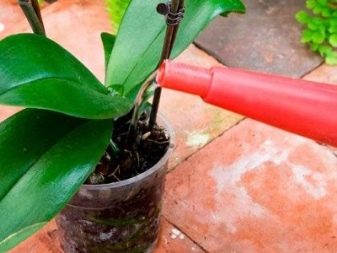
Priming
Currently, there is no shortage of soil for different plants in stores - even for such exotic ones as orchids. Therefore, you can use one of the ready-made offers. If you want to make a soil mixture with your own hands, then here is the approximate composition of the planting material for odontoglossum:
- vermiculite;
- coconut substrate (can be in the form of fiber, peat or chips);
- charcoal;
- bark of various trees;
- parts of fern roots;
- sphagnum moss;
- Styrofoam;
- perlite (or expanded clay);
- peat;
- cones of conifers.
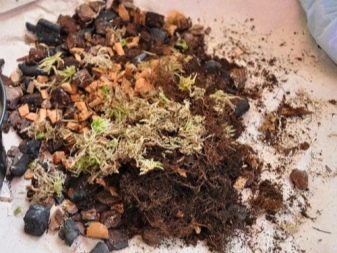
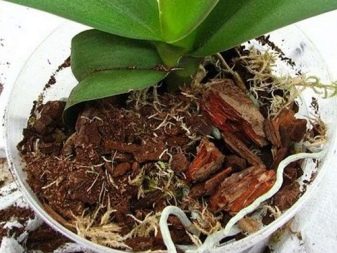
Important! Most of these elements provide the necessary air exchange, retain moisture and provide the plant with the necessary nutrition.
Diseases and pests
It is believed that odontoglossum is not too susceptible to various diseases, but sometimes problems do happen. One of these troubles is insects such as aphids, scale insects or spider mites. An infected plant can be easily recognized by the presence of fine cobwebs on the surface. The lack of flowering for a long time can also be a signal for concern. This insect is dangerous because in the active phase the mite begins to eat the plant, sucking out all the juices from it. As a result, the flower withers and dries up.
The insect can fly from the street through an open window or move from a nearby infected flower. In addition, it can be contained in the soil that was used when the plant was transplanted. Low humidity and high air temperature serve as a favorable habitat for it. To defeat the spider mite, first of all, it is necessary to increase the humidity of the air. The flower should be watered abundantly with water and wrapped in a plastic bag. That is you need to create a microclimate around it, in which the plant should stay for 2-3 days.
All this time, you need to carefully observe the flower - if it starts to fade, the bag should be removed.

And also helps from spider mites washing orchid leaves with a weak solution of water and dishwashing liquid or liquid soap.The solution is prepared in proportion to 1 liter of water 1 tbsp. l. liquids. With the same solution, it is necessary to rinse the place where the flower pot was. Severely damaged leaves must be cut off, and the cut must be treated with a solution of the drug "Previkur" (1 drop of the drug per 1 liter of water).
To combat harmful insects infecting the orchid, several preparations are recommended.
- Actellik. It is necessary to prepare the solution according to the instructions and apply as a spray. It is toxic and should only be used outdoors.
- Apollo. This drug is effective only for insect larvae. On adults, it has only a sterilizing effect.
- Fitoverm... This substance can be used indoors. Apply as a spray for a month at weekly intervals.
- Akarin. The drug is an analogue of Fitoverma according to the principle of action and method of application.
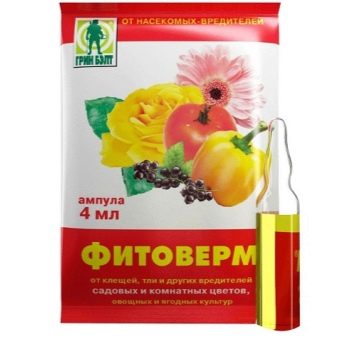
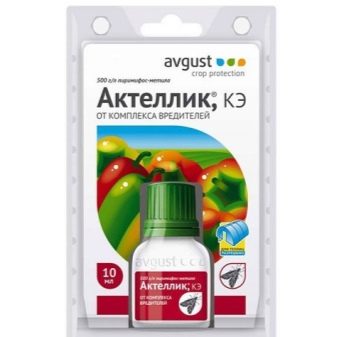
You can find out more about how to care for the odontoglossum orchid at home.































The comment was sent successfully.